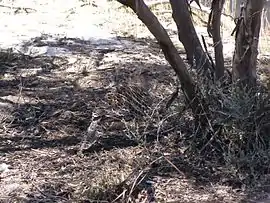| Peebinga Conservation Park South Australia | |
|---|---|
 The conservation park is an important site for malleefowl | |
 Peebinga Conservation Park | |
| Nearest town or city | Peebinga[2] |
| Coordinates | 34°58′52″S 140°49′30″E / 34.981126284°S 140.824969785°E[1] |
| Established | 14 March 1940[3] |
| Area | 33.61 km2 (13.0 sq mi)[4] |
| Managing authorities | Department for Environment and Water |
| See also | Protected areas of South Australia |
Peebinga Conservation Park (formerly Peebinga National Park ) is a 34 km2 protected area lying 40 km north of the town of Pinnaroo in the Murray Mallee region of south-eastern South Australia, about 240 km east of Adelaide and 10 km west of the Victorian border.
Description
The conservation park occupies a parcel of land that extends across the localities of Karte, Kringin and Peebinga from west to east and consists of all of the land in sections 19, 21, 22, 30, and 31 of the cadastral unit of the Hundred of Peebinga.[2][5]
The conservation park contains much land that was previously cleared for agriculture. It is characterised by remnants of mallee woodland on low, stabilised dunes. with regenerating open shrubland and grassland on sand plains.[6]
The conservation park is classified as an IUCN Category Ia protected area.[1]
History
The land under protection was first proclaimed as a flora and fauna reserve under the Crown Lands Act 1929 on 14 March 1940 in respect to sections 21, 22, 30, and 31 in the Hundred of Peebinga. On 30 September 1965, sections 19 and 30 were proclaimed under the Crown Lands Act 1929 as the Peebinga Wildlife Reserve. On 9 November 1967, the Peebinga National Park was proclaimed under the National Parks Act 1966 in respect to sections 19, 21, 22, 30, and 31. On 27 April 1972, the national park was reconstituted as the Peebinga Conservation Park upon the proclamation of the National Parks and Wildlife Act 1972.[5][3][7][8] In 1982, the conservation park was listed on the now-defunct Register of the National Estate.[9]
Flora and fauna
As well as grasses, the vegetation features ridge-fruited and slender-leaved mallee with warty cypress pine over broombush; the higher areas have square-fruited, red and white mallees.[6]
Fauna found in the conservation park includes western grey kangaroos and short-beaked echidnas.[6]
Peebinga Important Bird Area
The conservation park has been identified by BirdLife International as an Important Bird Area (IBA) because it supports a relatively large population of malleefowl. It previously had a population of the eastern mallee subspecies of the western whipbird (Psophodes nigrogularis leucogaster), which is now locally extinct.[10] Purple-gaped honeyeaters are present.[6]
See also
References
- 1 2 3 "Terrestrial Protected Areas of South Australia (refer 'DETAIL' tab )". CAPAD 2016. Australian Government, Department of the Environment (DoE). 2016. Retrieved 21 February 2018.
- 1 2 "Search results for Peebinga Conservation Park with the following datasets selected – 'Suburbs and Localities', 'NPW and Conservation Properties' and 'Gazetteer'". Location SA Map Viewer. Government of South Australian Government. Retrieved 2 May 2018.
- 1 2 Lyell McEwin, A. (14 March 1940). "FAUNA AND FLORA RESERVE" (PDF). The South Australian Government Gazette. South Australian Government. p. 537. Retrieved 1 May 2018.
- ↑ "Protected Areas Information System Reserve List" (PDF). Government of South Australia. 9 March 2018. Retrieved 26 April 2018.
- 1 2 "No. 56 of 1972 (National Parks and Wildlife Act, 1972)". The South Australian Government Gazette. Government of South Australia: 660 & 700. 27 April 1972. Retrieved 27 February 2018.
- 1 2 3 4 "Important Bird Areas factsheet: Peebinga". BirdLife International. Retrieved 7 June 2022.
- ↑ Shard, A.J. (30 September 1965). "CROWN LANDS ACT, 1929-1960: HUNDRED OF PEEBINGA—WILDLIFE RESERVES DEDICATED" (PDF). South Australian Government Gazette. South Australian Government. p. 1195. Retrieved 3 May 2018.
- ↑ Walsh, Frank (9 November 1967). "NATIONAL PARKS ACT, 1966: VARIOUS NATIONAL PARKS NAMED" (PDF). South Australian Government Gazette. South Australian Government. p. 2043. Retrieved 17 March 2018.
- ↑ "Peebinga Conservation Park – listing on the now defunct Register of the National Estate (Place ID 7947)". Australian Heritage Database. Australian Government. 28 September 1982. Retrieved 3 May 2018.
- ↑ "IBA: Peebinga". Birdata. Birds Australia. Retrieved 16 September 2011.